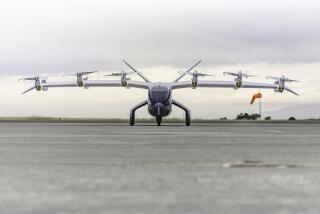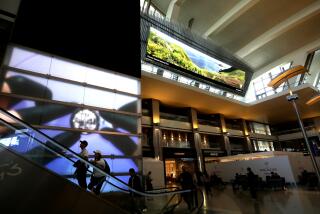Palmdale to run troubled local airport
Spurred by the planned departure of United Airlines from Palmdale Regional Airport next month, Palmdale officials say the city will assume primary responsibility for developing passenger service at the struggling facility and reduce the role of Los Angeles World Airports in the effort.
Palmdale Mayor James C. Ledford Jr. said the city will take over the Los Angeles agency’s lease of the terminal, parking lot and taxiways that sit on U.S. Air Force property and proceed with plans to attract another major airline to serve the Antelope and Santa Clarita valleys.
“This effectively removes LAWA from the airport’s operation,” Ledford said. “We have been diligent on this, but I don’t think we’ve had a willing partner.”
Palmdale would welcome continued support from the Los Angeles agency, Ledford said, but it would be accountable to the city and its role would be scaled back.
Gina Marie Lindsey, director of Los Angeles World Airports, said officials at her agency would not fight Palmdale’s takeover of the lease.
“If this is the direction they want to go, we won’t be an obstacle,” Lindsey said. “We will facilitate anything they want to do.”
Los Angeles World Airports operates Los Angeles International Airport, Ontario International Airport, Van Nuys Municipal Airport and Palmdale Regional Airport, where it acquired more than 17,000 acres in 1970.
Palmdale and Ontario have been part of LAWA’s effort to shift the growth in air travel away from busy LAX to other airports in the region -- a policy supported by Los Angeles Mayor Antonio Villaraigosa.
But eight airlines have come and gone from Palmdale since 1971, when Golden West Airlines began flights to LAX. In September, United Airlines, the latest carrier, announced it would end its four flights a day to San Francisco on Dec. 7.
United’s planes have been less than a third full, and the carrier has received almost $2 million in government subsidies to provide service for 18 months. Operations began in June 2007.
Los Angeles World Airports officials contend that the Palmdale market has been difficult to develop over the years despite steady population growth in the region and a heavy concentration of aerospace firms. The situation has been aggravated by high fuel costs and an unprecedented downturn in the airline industry.
Lindsey said United’s operation failed despite an advertising campaign by the L.A. agency and a subsidy from the city and federal government of about $230 per passenger. In addition, a key federal grant that helped pay for the operation could not be renewed, and United was demanding $6 million to stay another year.
“Palmdale demonstrates that LAWA is very committed” to regionalizing air travel, Lindsey said. “We’ve spent millions of dollars over the past 18 months -- over $2 million for advertising alone -- and we supported the grant applications for the city to get Federal Aviation Administration funding.”
After United announced it will cancel service, Ledford and Los Angeles County Supervisor Mike Antonovich complained to Villaraigosa and Los Angeles World Airports that Palmdale was no longer a priority for spreading airline service throughout the region.
Antonovich and Ledford said working with Los Angeles World Airports has been frustrating despite a 2006 court settlement requiring a regional approach to air travel and a 10-year-old agreement between Los Angeles and Palmdale to develop Palmdale airport.
Ledford said that when United leaves in December, the city will assume the lease of the terminal and other airport facilities from the Air Force, which owns the underlying property.
Los Angeles World Airports will retain ownership of the land around those facilities as well as a hangar and taxiway. Palmdale will be allowed to use the Air Force runways under a joint operating agreement.
“It is final. The city will be the leaseholder,” Ledford said. “I believe we can do at least as good a job as LAWA did.”
Taking control of the airport, city officials say, will give Palmdale and a coalition of airport supporters the chance to develop what they believe is a largely untapped market among the military bases, government installations and aerospace firms in northeast Los Angeles County.
Marketing studies show that almost 700,000 residents of the Antelope Valley and other communities in northeast Los Angeles County fly regularly out of LAX. Sales data also indicate that up to 20,000 people in the Antelope Valley buy airline tickets a month, but only a tiny fraction go to Palmdale while the vast majority head to other airports such as Bob Hope, Ontario and LAX.
Travel agents and aerospace firms contend that United offers too few flights at Palmdale and ticket prices are too expensive for military personnel and defense contractors to take advantage of under government travel programs.
“There is tremendous potential,” said John Smith, owner of American Travel Bureau in Lancaster. “I don’t understand why Edwards Air Force Base doesn’t have its people fly out of Palmdale instead of driving all the way to LAX. The problem is that every airline gives Palmdale a short-term look. If it doesn’t work when they want, they go.”
Dianne Knippel, communications director for Lockheed Martin Aeronautics, which employs about 3,700 people in the Antelope Valley, said Lockheed, Boeing Co., Northrop Grumman Corp. and Edwards would like better airline service at Palmdale.
“Get us to places we need to go, like Denver, Phoenix and Fort Worth, along with fares in line with the rest of the country,” Knippel said, “and we are good to go.”
--
More to Read
Inside the business of entertainment
The Wide Shot brings you news, analysis and insights on everything from streaming wars to production — and what it all means for the future.
You may occasionally receive promotional content from the Los Angeles Times.











